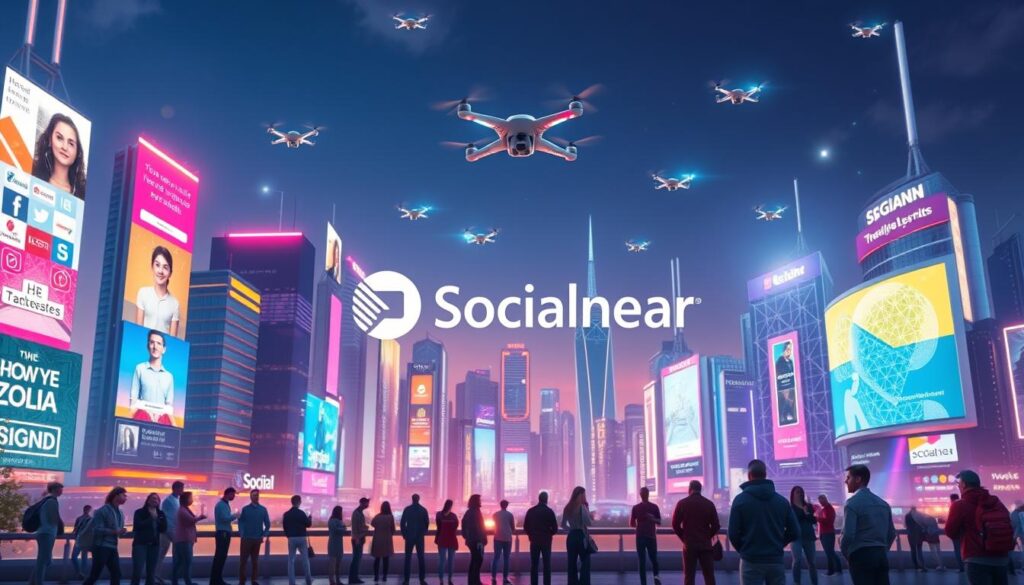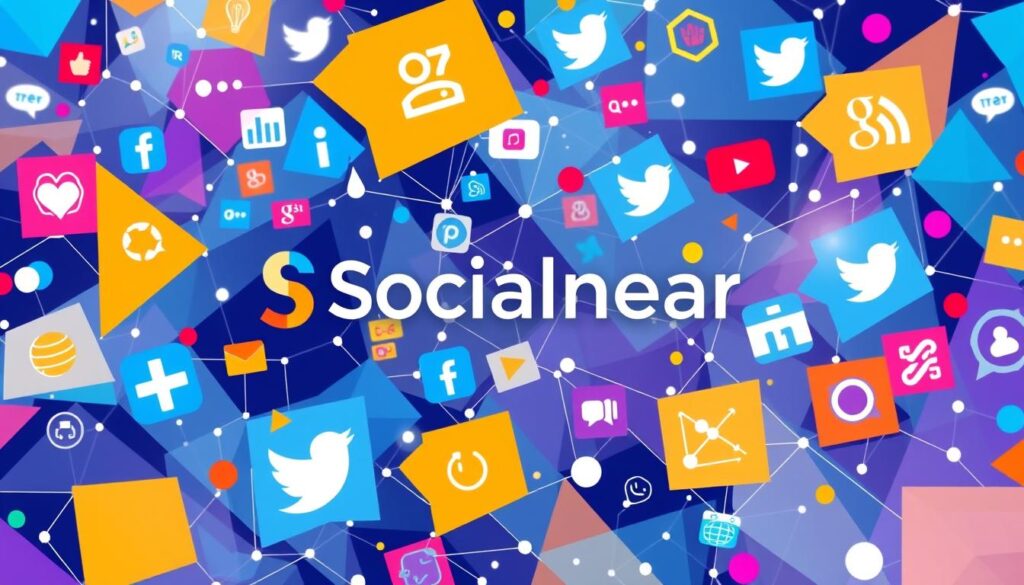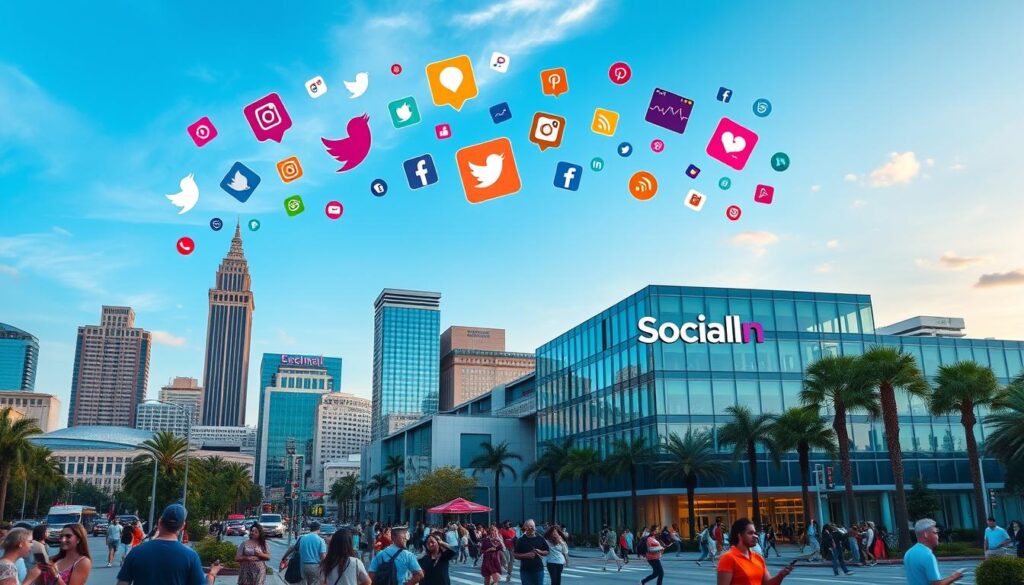In today’s world, local social media marketing is key for small businesses. It helps them get noticed, connect with their community, and bring in more customers. This guide will show you the best ways to use social media to reach out to people nearby.
Local social media marketing lets small businesses show off what they offer to people close by. Using sites like Facebook, Instagram, Twitter, and LinkedIn helps them build a strong local image. This way, they can make real connections with their community and grow their business.
Key Takeaways
- Local social media marketing can significantly boost small business visibility and community engagement.
- Leveraging the right social media platforms is crucial for effectively reaching and connecting with local customers.
- Developing a localized content strategy and creating a strong local presence are essential for small businesses.
- Analyzing performance metrics and collaborating with local influencers can further enhance the impact of local social media efforts.
- Engaging with the community and fostering user-generated content are key to building a loyal local customer base.
Introduction to Local Social Media Marketing
In today’s digital world, small businesses can’t ignore the importance of local social media marketing. This strategy focuses on hyperlocal content and customer mapping. It helps improve local SEO and builds strong ties with the local community.
What Is Local Social Media Marketing?
Local social media marketing uses social platforms to reach and engage with people in a specific area. By making content that meets the local audience’s needs, businesses can stand out. They can also build a loyal group of followers.
Importance for Small Businesses
For small businesses, local social media marketing is key. It helps them compete with big brands by focusing on their neighborhood. By using customer mapping and targeted content, small businesses can connect with their audience. This leads to stronger relationships, more foot traffic, and sales.
“Local social media marketing is the key to unlocking the full potential of your small business in the digital era. It’s about connecting with your community and becoming an integral part of their daily lives.”
By using local social media marketing, small businesses can become more visible. They can build trust and become the top choice for local customers.
Key Platforms for Local Social Media Marketing
Small businesses need to use the right social media platforms to be seen locally. Each platform has its own benefits for reaching out to the community and sharing your brand’s story. They are great for local marketing and advertising.
Facebook: Tools for Local Engagement
Facebook has many tools for small businesses to connect with locals. You can target ads and posts to people in your area. This helps you reach the right people and start meaningful conversations.
Instagram: Visual Storytelling for Local Brands
Instagram is perfect for local brands to show off their unique style. You can use it to share beautiful content that locals will love. Instagram’s features help your business get noticed by people in your area.
Twitter: Real-Time Engagement with the Community
Twitter is great for quick chats with your local community. You can follow hashtags and join in on local talks. This way, you can build strong relationships and keep up with what’s happening in your area.
LinkedIn: Networking for Local Professionals
LinkedIn is often seen as just for big businesses, but it’s also good for small ones. It helps you connect with local professionals and grow your network. By being active, you can show your business is reliable and trustworthy.
Using these social media platforms wisely, small businesses can really connect with their local audience. They can use geo-targeted campaigns and location-based ads to get noticed and engage with people in their area.
Developing Your Local Marketing Strategy
As a small business owner, creating a good local marketing strategy is key. It helps you use regionalized social strategies and proximity marketing well. This guide will help you find your target audience and create a brand voice that speaks to your local community.
Defining Your Target Audience
First, you need to know who your local customers are. Understanding their demographics, interests, and problems helps you make content that meets their needs. Use tools like buyer personas and social media analytics to learn about your audience.
- Identify the age, gender, income level, and geographic location of your target customers
- Understand their interests, hobbies, and pain points
- Analyze their social media activity and engagement patterns
Crafting a Unique Brand Voice
After knowing your audience, create a brand voice that makes you stand out. Your brand voice should show your business’s personality and values. It should also connect with your local community. Being consistent in your messaging and visual identity helps build trust and recognition.
| Elements of a Unique Brand Voice | Examples |
|---|---|
| Tone (e.g., friendly, professional, playful) | Friendly and approachable, emphasizing personalized service |
| Language (e.g., formal, casual, industry-specific) | Casual and conversational, using local slang and references |
| Visual Identity (e.g., logo, colors, imagery) | Vibrant colors and imagery that reflect the local community |
By defining your target audience and creating a unique brand voice, you’re on the right path. Your local marketing strategy will connect with your community and help your business grow.
Creating Localized Content
As a small business, making hyperlocal content that speaks to your community is key. It helps you build a strong local presence and engage with your community. Whether you run a café or a specialty store, local content tailored to your audience can draw in and keep local customers.
Importance of Localized Messaging
Localized content shows you get what your community needs and likes. By adjusting your messages and images for your area, you connect deeper with your audience. This makes your business seem reliable, trustworthy, and community-focused.
Types of Content That Resonate Locally
For hyperlocal content that hits home with your audience, think about these types:
- Neighborhood-specific updates and news
- Profiles on local personalities and community leaders
- Behind-the-scenes looks at your business
- Spotlights on local partnerships and collaborations
- Seasonal or holiday content that fits local traditions
- User-generated content from your loyal customers
| Content Type | Example | Benefits |
|---|---|---|
| Neighborhood-specific updates | Announcing a new community park opening or a local street fair | Demonstrates your involvement and investment in the local area |
| Profiles on community leaders | Highlighting the work of a beloved local artist or nonprofit founder | Fosters a sense of pride and connection with your audience |
| User-generated content | Sharing photos and stories from your customers’ experiences | Builds trust and authenticity by showcasing real local experiences |
By using these hyperlocal content types in your social media and marketing, you can engage your local community. This makes your small business a trusted and key part of the neighborhood.
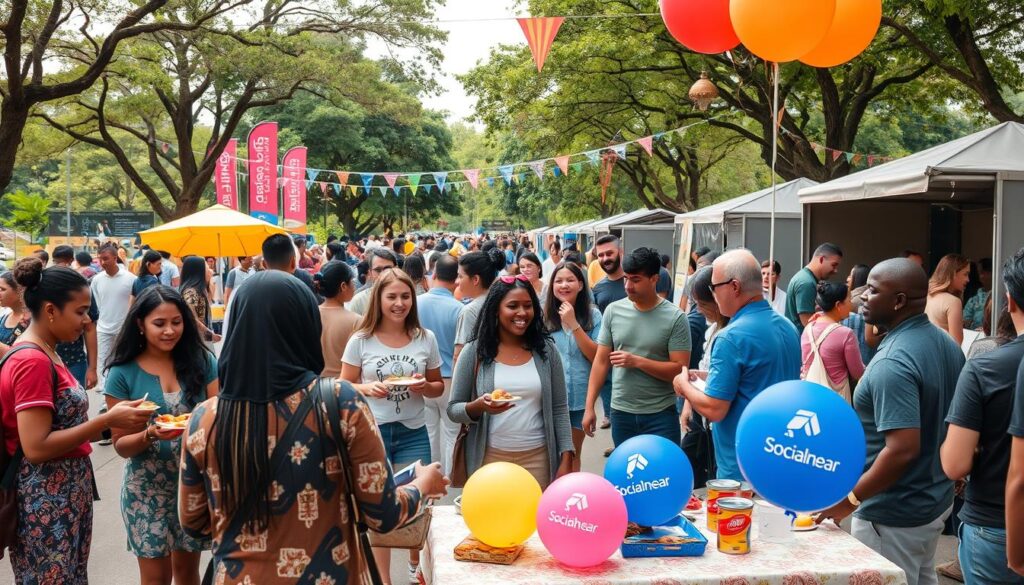
“Localized content is the key to building lasting relationships with your local customers. It shows that you truly understand and value their community.”
Building a Strong Local Presence
As a small business owner, it’s key to have a strong local presence on social media. By making your profiles better and posting regularly, you can connect with your community. This helps with local SEO and makes your brand more visible.
Optimizing Your Social Media Profiles
Make sure your social media profiles, like Facebook and Instagram, are set up for local searches. Use the right keywords, your address, and content that speaks to your audience. Keep your profile up-to-date with the latest info and images to show your brand well.
Consistent Posting and Engagement Tactics
Being active on social media helps build relationships and engage your community. Create a schedule for posts that mix promotions, info, and fun stuff for your local fans. Always reply to comments and messages quickly. This builds trust and makes you a reliable local business.
Building a strong local presence on social media starts with knowing your community and adding value. By putting in the work, your small business can grow and succeed over time.
Analyzing Your Local Social Media Performance
As a small business, it’s key to track your local social media success. This helps you improve your strategies and reach more people. By looking at important metrics, you can learn what your audience likes. This knowledge helps you make your regionalized social strategies more effective.
Key Metrics to Track
There are several important metrics to watch when evaluating your local social media performance:
- Reach: See how many people see your content, both locally and further away.
- Engagement: Look at likes, comments, shares, and more to see how your audience reacts.
- Customer mapping: Study your local followers’ demographics, interests, and behaviors to understand their needs.
- Conversion rates: Check how well your social media drives actions like website visits or in-store trips.
Tools for Performance Analysis
There are many tools to help you analyze your local social media performance. Some popular ones include:
| Tool | Key Features |
|---|---|
| Social Media Analytics | Provides detailed reports on engagement, audience demographics, and platform-specific metrics. |
| Google Analytics | Tracks website traffic and conversions from social media, including location-based insights. |
| Hootsuite | Offers tools for scheduling, publishing, and analyzing social media performance across multiple platforms. |
By using these tools and regularly checking your data, you can make smart decisions. This helps you improve your customer mapping and regionalized social strategies. This way, you can get better results for your local small business.
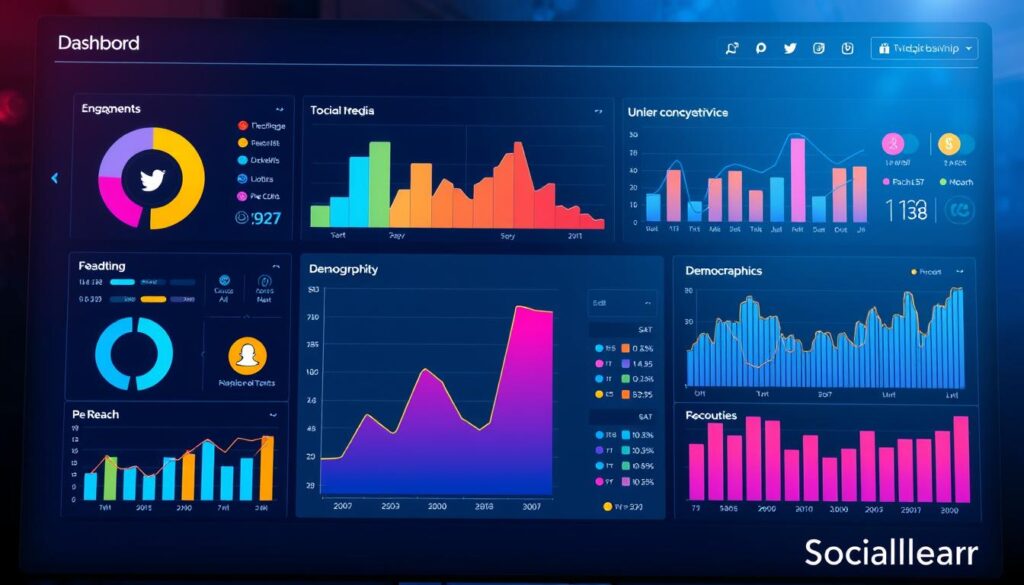
“Data-driven decision making is the key to unlocking the full potential of your local social media marketing efforts.”
Collaborating with Local Influencers
Working with neighborhood influencers can really help small businesses grow. These influencers know their local communities well. They can help you connect with your audience in a real way and reach more people.
Finding the Right Influencers in Your Area
Finding the right local influencers is the first step. Look for people with a big following in your area. Make sure their values and interests match yours. Check their engagement rates, content relevance, and their success in working with brands.
- Use social media to find local micro-influencers and community leaders.
- Go to local events and gatherings to meet influencers.
- Ask industry associations, community groups, and local organizations for suggestions.
Building Mutually Beneficial Relationships
After finding the right influencers, start building relationships. Think long-term and focus on adding value for both sides. Give influencers special access, behind-the-scenes content, or chances to work together.
| Benefits for Your Business | Benefits for Local Influencers |
|---|---|
| More people will know about your brand in the local community. | Get exclusive access to new products, services, or experiences. |
| Improve community engagement and keep customers loyal. | Get to work together and create content. |
| Reach more people and find new audiences. | Grow your own brand by getting more exposure. |
By building strong relationships with neighborhood influencers, you can achieve great things for your small business. It’s all about working together for the best results.
Running Local Promotions and Contests
Using social media for local promotions and contests can really help your brand. It boosts awareness, builds loyalty, and encourages people to interact. It’s key to be creative but also follow the law and ethics.
Creative Ideas for Engagement
Get your local audience’s attention with campaigns that are right on target. Try a “Explore Your Neighborhood” contest where people share their favorite spots. You could also offer special deals to those who check in at your place.
Legal and Ethical Considerations
Local promotions are great, but they must follow the law and ethics. Make sure your contest rules are clear and fair. Also, respect people’s privacy and data to keep their trust.
| Legal Considerations | Ethical Considerations |
|---|---|
|
|
Small businesses can make a big impact by balancing creativity with responsibility. Using geo-targeted campaigns and proximity marketing can help build strong community ties and achieve great results.
Engaging with Your Community
As a small business owner today, it’s key to connect with your local community. Social media helps you make real connections with customers. It makes you a big part of your neighborhood.
Responding to Customer Feedback
Start by listening to what your customers say. Watch your social media for feedback, good or bad. Reply quickly and personally. This shows you care about their thoughts and want to give them the best experience.
Be thankful for nice comments and try to fix any problems with kindness. This builds trust and loyalty.
Hosting Local Events via Social Media
Social media is great for planning and sharing community events. You can host meetups or online workshops. Use your social media to get people excited and involved.
Share content that shows you’re part of the community. This strengthens your bond with local people.
| Event Type | Potential Benefits |
|---|---|
| In-Person Meetups | Opportunity for face-to-face interactions, building stronger customer relationships, and showcasing your local expertise. |
| Virtual Workshops | Reach a wider audience, provide valuable educational content, and demonstrate your thought leadership in the industry. |
| Charity Fundraisers | Demonstrate your commitment to the community, foster goodwill, and potentially attract new customers who share your values. |
By engaging with your community, you can grow a loyal customer base. Your small business will be seen as trustworthy and valuable in the neighborhood.
Leveraging User-Generated Content
In local social media marketing, using user-generated content (UGC) can change the game for small businesses. By asking local customers to share their stories, you build a strong community. This also helps you gain trust with your audience.
Encouraging Local Customers to Share Their Experiences
To start using UGC, create a space for local customers to share. Run campaigns, offer incentives, or just be welcoming online. When customers feel valued, they’re more likely to share their experiences with you.
Showcasing Customer Stories on Your Profile
Once you have UGC, show it off on your social media. Share their stories and photos to give them credit. This builds trust and shows your business is part of the local community.
| Benefits of Leveraging UGC | Strategies for Effective UGC Curation |
|---|---|
|
|
By using UGC, small businesses can make a strong community engagement strategy. This boosts their local presence and connects them with customers. It also builds trust and gives you real content for your marketing.
“Embracing user-generated content is a surefire way to create a vibrant and engaged community around your local business.”
Conclusion: Embracing Local Social Media Marketing
Local social media marketing is a game-changer for small businesses. It helps them connect with their community, grow their brand, and increase sales. By using platforms like Facebook, Instagram, Twitter, and LinkedIn, businesses can make a big impact.
Final Tips for Success
To really make your social media work, create content that speaks to your local audience. Work with local influencers and engage with your customers. Always check how well your efforts are doing and adjust your plans to meet your small business visibility goals.
Encouragement to Start Your Journey Today
It’s time to dive into local social media marketing. This approach can help your business grow, build loyalty, and succeed in the long run. So, don’t wait. Start your journey today and watch your business flourish online.
FAQ
What is local social media marketing?
Local social media marketing uses social media to reach people in a specific area. It includes making content for that area, running ads for it, and working with local influencers. This helps small businesses get noticed and build strong ties with their community.
Why is local social media marketing important for small businesses?
It’s key for small businesses to connect with their local community. It boosts their visibility and brings in more customers. By using content and strategies specific to their area, they can stand out and connect deeply with their audience.
What are the key platforms for local social media marketing?
Key platforms include Facebook, Instagram, Twitter, and LinkedIn. Each has special features for local marketing. For example, Facebook helps with local engagement, Instagram is great for visuals, Twitter is for real-time talks, and LinkedIn is for professional networking.
How do I develop an effective local marketing strategy?
First, know your local audience and create a brand voice they’ll love. Then, make content for them, optimize your profiles for local SEO, and talk to your audience. This includes responding to feedback and hosting local events.
How do I measure the success of my local social media efforts?
Track engagement, audience growth, website traffic, and foot traffic. Use tools to see how your strategies are working. This helps you improve and make a bigger impact in your area.
How can I collaborate with local influencers?
Working with local influencers can boost your reach and engagement. Find influencers who match your brand and have a local following. Work together on content, events, or promotions to reach more people.
What are some ideas for running local promotions and contests?
Try giveaways, loyalty programs, photo contests, and scavenger hunts. Make sure to follow legal and ethical rules, like disclosing sponsorships and ensuring fair play.
How can I effectively engage with my local community?
Respond quickly to feedback, both good and bad, on social media. Also, use social media to promote local events. This shows you care about your community and strengthens your ties.
How can I leverage user-generated content for local social media marketing?
Run campaigns that encourage customers to share their experiences. Use their stories and reviews to build trust and show your community. This strengthens your connections and builds your reputation.

